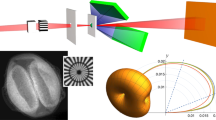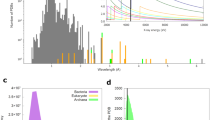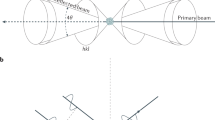Abstract
IN NATURE of April 22, 1939, I described an optical method of summing a double Fourier series, and so of producing an image of a crystal structure. To get a projection of the structure in a direction parallel to the b axis, for example, holes are drilled in a brass plate in the positions of cross-grating spectra. Each X-ray reflexion hol is represented by a hole the area of which is proportional to F (hol). When a parallel monochromatic beam passes through these holes, and then through a lens, the Fraunhofer fringes build up an image of the crystal structure which can be viewed through a microscope. Since a wide range of holes is required, arid they are one or two millimetres apart, the smallest holes must be very fine. I am indebted to Dr. E. W. Fish for supplying me with a series of minute drills.
This is a preview of subscription content, access via your institution
Access options
Subscribe to this journal
Receive 51 print issues and online access
$199.00 per year
only $3.90 per issue
Buy this article
- Purchase on Springer Link
- Instant access to full article PDF
Prices may be subject to local taxes which are calculated during checkout
Similar content being viewed by others
References
Perutz, M., NATURE, in the press.
Author information
Authors and Affiliations
Rights and permissions
About this article
Cite this article
BRAGG, W. The X-Ray Microscope. Nature 149, 470–471 (1942). https://doi.org/10.1038/149470a0
Issue Date:
DOI: https://doi.org/10.1038/149470a0
Comments
By submitting a comment you agree to abide by our Terms and Community Guidelines. If you find something abusive or that does not comply with our terms or guidelines please flag it as inappropriate.



